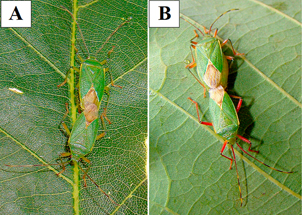Abstract
The reproductive behavior of the oak bug Urostylis annulicornis Scott, 1874 was studied for the first time. This species lives in the crown of tall Quercus mongolica Fisch. ex Ledeb. trees making it difficult to access for study and observation. Our study aimed to elucidate the timing of mating and oviposition of U. annulicornis and the effect of temperature variations on the lifespan of adults in natural conditions. Nymphs grown from eggs that had overwintered on rhytidome fragments were placed in stationary netting cages installed on oak saplings, where the bugs were kept until adulthood. The behavior of the control pairs was monitored for 15 hours a day (from 06:00 to 21:00). The duration of an uninterrupted tandem during copulation was confirmed by additional observations at night. To facilitate egg-laying, artificial shelters were created from pieces of oak bark stacked together, attached to the stem of the plant, and placed inside cages. The number of eggs laid by the female was counted and photographed. The process of oviposition by a female on the oak tree bark in natural conditions was recorded and documented for the first time. This study of the biology of U. annulicornis, from oviposition through the sequence of postembryonic development, documenting all stages of metamorphosis, was carried out on a single plant. A summer reproductive diapause was observed in the seasonal cycle of the species. The timing of mating in U. annulicornis was shifted to autumn, the laying of overwintering eggs occurred in October, as night temperatures decreased. Males were observed performing postcopulatory mate-guarding. The effect of night cold spells on the lifespan of bugs was recorded: natural mortality of adults occurred when the night temperatures dropped below zero.
References
- Honek A. & Martinkova Z. 2019. Behavioural thermoregulation hastens spring mating activity in Pyrrhocoris apterus (Heteroptera: Pyrrhocoridae). Journal of Thermal Biology 84: 185–189. https://doi.org/10.1016/j.jtherbio.2019.07.013
- Kaiwa N., Hosokawa T., Nikoh N., Tanahashi M., Moriyama M., Meng X.-Y., Maeda T., Yamaguchi K., Shigenobu S., Ito M. & Fukatsu T. 2014. Symbiont-supplemented maternal investment underpinning host’s ecological adaptation. Current Biology 24: 2465–2470. https://doi.org/10.1016/j.cub.2014.08.065
- Kanyukova E. V. 1988. Family Urostylidae, p. 909–911. In Opredelitel’ nasekomykh Dal’nego Vostoka SSSR (Keys to Insects of the Far East of the USSR). Vol. 2: Ravnokrylye i poluzhestkokrylye (Homoptera and Hemiptera) (P. A. Lehr, editors). Leningrad, Nauka, 972 pp. (in Russian)
- Kanyukova E. V. 2010. 34. Family Urostylidae Dallas, 1851, p. 222–223. In Catalogue of the Heteroptera of the Asian part of Russia. (Yu. A. Popov editors). Novosibirsk, Nauka, 317 pp. (in Russian)
- Kanyukova E. V., Markova T. O. & Maslov M. V. 2023a. Biological Features of Urostylis annulicornis Scott (Heteroptera, Urostylididae) in the South of the Russian Far East. Entomological Review 103(1): 21–32. https://doi.org/10.1134/S0013873823010049
- Kanyukova E. V., Markova T. O. & Maslov M. V. 2023b. New data on Urostylis lateralis Walker, 1867 (Heteroptera, Urostylididae) from the South of the Russian Far East. Journal of Insect Biodiversity 42(2): 31–34. https://doi.org/10.12976/jib/2023.42.2.1
- Kanyukova E. V., Markova T. O. & Maslov M. V. 2024. New data on Urostylis trullata Kerzhner, 1966 (Heteroptera, Urostylididae) from the South of the Russian Far East // Journal of Insect Biodiversity 45(2): 52–56. https://doi.org/10.12976/jib/2024.45.2.3
- Kerzhner I. M. 1966. Shield bugs of the family Urostylidae (Heteroptera, Pentatomoidea) from the USSR. Trudy Zoologicheskogo Instituta Akademiya Nauk SSSR 37: 45–50. (in Russian)
- Kobayashi T. 1965. Developmental stages of Urochela and an allied genus of Japan (Hemiptera: Urostylidae). (The developmental stages of some species of the Japanese Pentatomoidea, XIII). Transactions of the Shikoku Entomological Society 8: 94–104.
- Kuznetsov V. N. 2000. Materials for assessment of insect biodiversity in the Sikhote-Alin Nature Reserve. In Rastitel’nyi mir Sikhote-Alinskogo biosfernogo zapovednika: raznoobrazie, dinamika, monitoring (Vegetation of the Sikhote-Alin Biosphere Reserve: Diversity, Dynamics, and Monitoring) (A. A. Astafiev, editors). Vladivostok: Biologo-Pochvennyj Institut, p. 255. (in Russian)
- Markova T. O., Maslov M. V. & Repsh N. V. 2018. Modifications of rearing cages for insect research. Euroasian Entomological Journal 17(5): 345–348. (in Russian) https://doi.org/10.15298/euroasentj.17.5.06
- Ranade S. & Ghate H. V. 2023. Notes on morphology and bionomics of Urolabida histrionica (Westwood) (Heteroptera: Urostylididae) from Assam, India. Journal of Threatened Taxa 15(2): 22677–22685. https://doi.org/10.11609/jott.8005.15.2.22677-22685
- Rider D. A. 2006. Family Urostylidae Dallas, 1851. p. 102–116. In Catalogue of the Heteroptera of the Palaearctic Region. Vol. 5. (B. Aukema, Chr. Rieger, editors). Amsterdam, The Netherlands Entomological Society, pp. 102–116.
- Saulich A. Kh. & Musolin D. L. 2014. Seasonal cycles in stink bugs (Heteroptera, Pentatomidae) from the temperate zone: diversity and control. Entomological Review 94(6): 785–814. https://doi.org/10.1134/S0013873814060013
- Socha R. & Zemek R. 2004. Mating behaviour and wing morph-related differences in the sexual activity of a flightless bug, Pyrrhocoris apterus (L.) (Heteroptera). Ethology Ecology & Evolution 16(3): 217–229. https://doi.org/10.1080/08927014.2004.9522633


